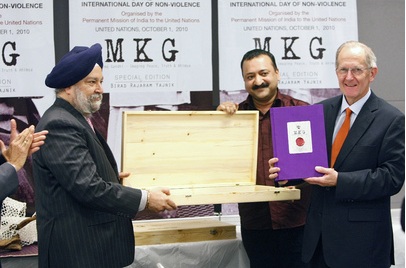By NIRUPAMA RAO - Ambassador of India to the United States.
Having won our independence in a nonviolent struggle, Indians join Americans in celebrating the Rev. Martin Luther King Jr.’s leadership of the civil rights movement in the United States. On Aug. 28, we will commemorate the 50th anniversary of the March on Washington where King delivered his “I Have a Dream” speech, and, on April 4, we will mourn the 45th anniversary of his assassination.
On March 10, we will mark another milestone moment in King’s public ministry and personal journey. On that day, 54 years ago, he returned from a monthlong journey to India where he rededicated himself to the nonviolent struggle for justice to which the leader of our nation’s independence movement, Mahatma Gandhi, gave his life.
King carried forward Gandhi’s commitments — and Indians enthusiastically embraced King’s campaigns — because both shared common values, common strategies and common struggles. While each leader’s life was cut short by violence, both these prophets of peace still have much to teach a world plagued by war, terrorism, discrimination and divisiveness.
Through most of the past century, Indians and African-Americans supported each other’s struggles because we identify with each other’s predicaments and principles. While born and raised in India, Gandhi first struggled for social justice in South Africa where he protested peacefully against discrimination against Asians as well as Africans.
Returning to India in 1914, he developed the doctrine of Satyagraha — nonviolent resistance to evil. This watchword has been translated as “truth force,” “love force” — and, in a phrase made famous by the U.S. civil rights movement, “soul force.” From the Salt March in 1930 to hunger strikes and prison terms, our nonviolent struggle won our independence in 1947.
Gandhi also reached out to African-Americans, spreading seeds of nonviolent protest that King would ultimately harvest. In 1929, he authored a short article in the NAACP magazine, The Crisis, and in 1935 he met with a group of African-American leaders visiting India, including Benjamin Mays, who later became president of Morehouse College in Atlanta, which King attended.
As a mentor to King, Mays encouraged him to read Gandhi’s writings, which informed King’s leadership of the bus boycott in Montgomery, Ala., in 1955. King later wrote that Gandhi’s teachings were “the guiding light of our technique of nonviolent social change.”
Meanwhile, leading stalwarts of the nonviolent movement in India watched King with interest. After visiting the U.S. in 1956, India’s Prime Minister Jawaharlal Nehru said he wished he had met King. In January 1959, Harishwar Dayal of the Indian Embassy passed along a letter from the Gandhi National Memorial Fund inviting King to visit India.
Accepting the invitation, King arrived in India on Feb. 10, 1959, declaring: “To other countries, I may go as a tourist but to India I come as a pilgrim.” Having dinner with Nehru on their second night in India, King and his wife, Coretta Scott King, toured the country, meeting with leaders, scholars and everyday citizens and discussing issues of poverty, economic policy, race relations and world peace. In a broadcast on All India Radio, King said: “If this age is to survive, it must follow the way of love and nonviolence that [Gandhi] so nobly illustrated in his life.” King later wrote in Ebony magazine that many Indians were better informed about the bus boycott than many Americans. His visit to India was a revelation in many ways, as if “the spear of frustration” had been transformed “into a shaft of light.”
After his trip, King wrote: “I have returned to America with a greater determination to achieve freedom for my people through nonviolent means.” His commitment to peaceful protest informed his later efforts, including his campaign in Birmingham, Ala., and the March on Washington, both of which took place a half-century ago.
Fifty years after King’s visit to India, the U.S. House of Representatives unanimously passed a resolution introduced by Rep. John Lewis (D-Ga.) recognizing Gandhi’s influence on King. During February 2009, King’s son, Martin Luther King III, Lewis and other Americans visited India, retracing the martyred civil rights leader’s pilgrimage 50 years earlier.
In today’s world, Gandhi and King continue to inspire the leaders of nonviolent freedom struggles, from Nelson Mandela in South Africa to Aung San Suu Kyi in Myanmar. Their lives and legacies — and King’s journey to India — still offer new paths to global peace and human progress.
Source:
http://www.politico.com/story/2013/03/mahatma-gandhis-lightguided-martin-luther-king-jr-88581.html







